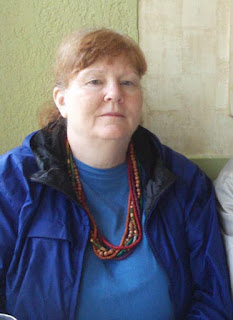Why I Fast (The Long Version): No More Sleep Apnea, Appetite Correction, Autophagy, and Weight Loss/Maintenance
 |
| Jennifer in 2010 -- Her thick neck in this photo is indicative of Sleep Apnea. ___________________ |
Diagnosis: Sleep Apnea.
It was May 2016 when the Pulmonologist delivered the bad news.
I weighed in at 196 – not my all-time high, but high enough (In the late
1990’s, I tipped the scales at a whopping 230 pounds, morbid obesity territory,
given my small bone structure).
Before the diagnosis, I had decided to stop dieting altogether – I was 65,
after all, and after so many diet failures, enough was enough.
Never mind that I was beginning to experience mobility issues and
shortness of breath after walking just one block. And uphill walking? My heart seemed
to pound against my ears.
Still, these issues weren’t enough to send me to Dietland – I was having
enough trouble navigating through the portal of Elderland without worrying
about my weight.
But Sleep Apnea?
This sounds serious. Scary.
Moreover, I would need to use a CPAP, possibly for the rest of my life.
The CPAP, my new worst enemy.
I despised that CPAP – I hated its noisy intrusion in my life, the
blurpppfff of the mask at 4:00 a.m.
I hated dragging it with me when I traveled.
I hated having to buy distilled water to feed its greedy little humidifier.
Seeking a possible cure and a way to wean myself off the CPAP, I
researched Sleep Apnea – most medical sites suggested losing weight, although
they didn’t always explain why.
But excess weight seemed to be a commonality among Sleep Apnea sufferers.
WebMD notes that “More than half of people with obstructive sleep apnea
are either overweight (body mass
index, or BMI, of 25-29.9) or obese (BMI
of 30.0 or above).”
Okay, so I would lose weight, and, this time, I would keep it off. After
all, I had found my “why,” and didn’t all diet gurus insist that once you find your
“why,” the weight just falls off and stays off?
This is a big fat lie.
But late in 2017, after reaching goal weight, I had yet to experience
this revelation, as evidenced in The “Why” and Conversations with My CPAP.
I later discovered that neck size has more to do with Sleep Apnea than
overall body weight, although overweight and obese people tend to have more fat
deposits in the neck area (but not always – we’re all different in the way we
manifest fat deposits). The Sleep Foundation notes that “Excess weight
creates fat deposits in a person’s neck called pharyngeal fat. Pharyngeal fat
can block a person’s upper airway during sleep when the airway is already
relaxed. This is why snoring is
one of the most common sleep apnea symptoms — air is literally being squeezed
through a restricted airway, causing a loud noise.”
This was certainly true in my case; as I look at one of my “before”
photos (above), I notice that my neck area was fairly thick (See another photo here.)
Conversely, one can be slender and still be at risk for Sleep Apnea if one’s
neck area contains a lot of fat deposits. Typically, a common marker of Sleep
Apnea, irrespective of body size, is a thick neck, above 17 inches (43
centimeters) for men and above 15 inches (38 centimeters) for women. (WebMD)
Other possible risk factors for and causes of Sleep Apnea include the
following:
·
A narrow throat [for example, a narrow airway]
·
A round head
·
Excess growth due to hormones (acromegaly)
·
Deviated septum (problem
with nose structure)
·
Medical conditions that congest upper airways
·
Smoking
·
Alcohol or drug
abuse
(WebMD)
Back in 2016, I did not delve too deeply into these other causes of Sleep
Apnea, and I’m glad I didn’t – I didn’t need an excuse to remain obese.
On May 11, 2016, I returned to Weight Watchers and, over 15 months,
successfully lost 76 pounds.
In October 2017, a sleep test revealed no more Sleep Apnea, and no more
CPAP needed.
Yay, me!
For about three months, I maintained my weight at about 130 pounds.
Then in early 2018, “The Beast” switched on big time – my “why” no longer
worked; it could not tame a voracious appetite. I was suddenly hungry all the
time, and I couldn’t figure out why.
For the next year and a half, I battled The Beast, occasionally winning but mostly losing; no matter what I did, The Beast would
not leave me alone. I watched helplessly as the pounds slowly piled on –again.
By late 2019, my weight had crept up to 155 pounds from 130.
Here we go again.
A familiar arc of my life.
Why can’t I keep weight off?
I have no problem losing weight – I have done it several times in my
life.
Sound familiar?
I’m a professional dieter: I know how to cook low fat meals, to cut out
refined foods (junk food and sugar), to weigh and measure portions, to use
diversionary measures to take my mind off The Beast. I know what to do and how
to do it.
I was eight when I embarked on my first diet, complete with amphetamines,
prescribed by my family doctor, who, himself, weighed in at about 300 pounds –
a whole other story, which I fictionalized in my short story “Are You EVER
Going to be Thin?” [Are You EVER Going to Be Thin (and other stories)]
and “Are You Thin Yet?” (essay), posted here.
Before every diet, I would vow to eat nutritious food and a lot less of
it. And for a time, I could stick to it, but then, just short of my goal
weight, a funny thing would happen: a “switch” would go off in my head, and The
Beast would start to awaken and growl.
I ended up eating more than ever. It was as if my body was always on the
verge of starvation, although it was obvious that I was well-fed – too well
fed.
What I didn’t understand at the time: that without appetite correction,
all diets are doomed to failure –
more on this later.
So here I was, in December 2019, at a crossroads.
I wasn’t quite fat yet – well, perhaps a bit plump. I’m short and small
framed, so I don’t hold any extra weight well.
What to do?
What was there to do?
I had been on every diet under the sun, sometimes several times each – you
know, trying the same thing over and over and expecting a different result.
Give up and give in to the dreaded CPAP?
It was pre-pandemic, around Christmas time, when food and booze flowed
like a rushing river, threatening to overwhelm my body with even more fat.
Then I read The Article That Changed My Life Forever in my local
newspaper about a local doctor who was advocating something called “Intermittent
Fasting” (IF)
Whaaa-a…t-t-t?
I don’t remember the specifics of the article except that it was short and
that an actual doctor was advocating fasting, a no-no on the myriad diet
programs out there. Here was this doctor poking holes in all the sacrosanct truisms
regarding diets:
·
Don’t skip breakfast (that sainted first meal of
the day)
·
Don’t skip meals
·
Eat three times a day, plus two snacks, maybe
even three snacks.
The idea that if you kept your body well-fed throughout the day and
evening, you could keep The Beast at bay.
Except that this paradigm has never worked for me.
Then I remembered what my late grandmother, another professional dieter,
would often say: “Eating makes me hungry.”
At the time, her comment didn’t quite register because I was too busy
being a teenager and dissing whatever she said, but I now suspect she was doing
a version of IF because she was somewhat successful at keeping her weight in
check.
And, now, here was this doctor confirming my grandmother’s words of
wisdom.
In modern medicine, fasting has received a bad rap, unfairly, I must say –
often associated with disordered eating, which can happen if a faster fails
to eat properly during the eating window. And there are some people who should probably
not intermittent fast, discussed in Is Intermittent Fasting for You?
You see, IF is a balance between feast and fasting. In other words,
fasting does not mean undereating or starving. In The Obesity Code, Dr. Jason Fung discusses the role of fasting as a rite
in several world religions and as a survival tactic in the caveman era, when
food was often scarce (fasting) and plentiful (feasting). If our bodies were
not attuned to fasting, our species would have died out long ago.
Therefore, we are built to fast during periods of famine and to feast
during periods of plenty.
Even in the 1800’s, people limited their eating to three meals a day,
having their major meal (dinner) in the
middle of the day. The types of food eaten depended on the season – more fresh
meats, fruits, and vegetables during harvest, more cured meat and dried beans
during winter and lean times. It is likely that a light breakfast was eaten very
early in the morning and the third meal was eaten in late afternoon or early
evening. By default, the fasting period was likely 12 or 13 hours a day, the eating
window about 11 to 12 hours, creating a balance between fasting and eating. Keep
in mind that people did not eat constantly during their eating window, but,
essentially, kept to a regular three-meal schedule, creating a balance of
feasting and fasting (12/12).
But in our culture of 24/7 bounty, our access to food is pretty much
endless. Unfortunately, unfettered access has resulted in constant snacking –
and a shorter fasting window, sometimes only eight hours or fewer!
For example, if one typically eats breakfast at 8:00 a.m., a snack at
10:00 a.m., lunch at noon, another snack at three p.m., dinner at six or seven
p.m., a snack at 10:00 p.m., that equals 10 or 11 hours of frequent eating each
day, creating at least six opportunities for raising insulin levels, not good
for the human body. In short, our bodies are not built for continuous
eating during long eating windows.
Unfortunately, our current eating way of life has created a constellation
of modern diseases related to rising insulin: type 2 diabetes (which often contributes
to other problems, such as kidney, eye, neuropathy, pancreas, among other diseases),
obesity, gallstones, cancer, and heart disease.
Our forks are literally killing us.
So what to do about this if diets don’t work anyway?
Why doesn’t “eat less, move more” work? It should work, but it doesn’t
because it doesn’t factor in the “The Beast.”
All my life I was told that my outsized hunger was in my head, that my
need to constantly eat was a psychological flaw.
I embarked on years and years of psychotherapy, all centered around my fake
hunger and its possible roots in childhood trauma. The idea was to slay The
Beast through talk therapy, hypnosis, diet pills, group therapy etc., etc.
None of these therapies worked long-term.
Why? Because
·
My hunger was real, not in my head. Even though
I was fat and well-fed, my body still cried out for food, even though I had
just eaten an hour or two before.
·
My appetite never had a chance to “correct”
itself because my insulin levels never leveled off and dropped as they are
supposed to do. The three meals/three snacks paradigm made sure that my insulin
levels stayed constantly high.
·
Insulin, a necessary hormone that manages blood
sugars (among other functions), is also a fat creator. Yes, a FAT
creator. This is why formerly untreated Type 1 diabetics tend to gain weight
once they start insulin therapy.
So, how to kick The Beast to the curb?
As promised earlier, let’s talk “Appetite Correction” – because this is
the key to real and sustained weight loss. Without this, nothing else matters.
Our bodies need to fast each day (some of which occurs when we sleep);
during the fasting hours, our bodies are shedding a thin layer of fat and going
through a process called autophagy, a process that cleans up dead cells,
kills sick cells, and creates new healthy cells. During autophagy, the body is
eating itself, a necessary biological process.
During our eating hours, we gain back the thin layer of fat and autophagy
pauses. In a balanced world, if we eat for 12 hours and fast for 12, we should maintain
a constant weight. But, of course, we don’t live in a perfect world, for if we
eat nothing but junk food for 12 hours straight, our insulin levels will spill
over during our fasting hours. Our ancestors may have had a 12-hour eating
window, but they didn’t constantly eat all day – they enjoyed defined mealtimes
– and they didn’t snack on potato chips and drink sugary teas and sodas. They
ate whole foods and according to the season.
So Intermittent Fasting, a healthy diet, and moderate exercise are key to
kicking The Beast in the butt.
I can’t tell you how to forge your own eating plan on IF because we’re
all different, so you will not see a diet plan on my site. Some people do well
on Keto – I’m not one of them – but I can tell you that I created my own
journey with a lower carb/higher protein diet for everyday eating.
I also allow myself special foods for celebratory occasions.
My mantra: “I can eat anything, just not everything.” Think about that.
At first, the concept of fasting scared me. I associated fasting with
starvation, which it is not, unless you embark on 48-72-hour fasts. That was
never my path.
I started small, with a 14/10 fast/eating window. At first, I approached it like
a traditional diet, trying to squeeze in three meals a day – I soon discovered
that was too restrictive. It seemed I was always fixing meals, and it was
driving my husband nuts!
I switched to two meals a day (skipping the morning meal), with maybe a
small snack. But as I extended the fasting hours to 15, 16, 17, 18, 19, 20
hours a day, the snack fell by the wayside.
Now the longer the fast, the smaller my last meal of the day. At 20
hours, my eating window becomes one meal a day (OMAD) with a snack. But I don’t
fast for 19 or 20 hours too often. My sweet spot seems to be 17-18 hours. It’s
my comfort zone, my feel-good zone.
At first, none of this was easy. The Beast continued to be an issue, and
each day was a constant battle with hunger, my weight loss was slower than I
wished – that is, until about 10 or 11 months into IF.
Then I began to notice that when I ate a reasonable amount of food, I got
full faster, and I remained full. My weight loss accelerated (the opposite of
what usually happens on a “diet”), and I no longer felt deprived. My constant
cravings for sugar: GONE! That’s not to say that I never get a hankering for
something sweet – I do – but it’s reasonable and, well, normal. I get skinny-person
cravings which means I can slake my craving with a small piece of something sweet,
not an entire cake or a bag of large potato chips.
For those who have never struggled with The Beast, this may seem like a minor
victory, but I’m here to tell you that The Beast controlled me for most of my
life, including my childhood.
And. Now. It.
Doesn’t.
That’s BIG!
And I was able to accomplish this without diet pills, special foods, expensive
diet programs, onerous exercise (just moderate walking and meeting with a trainer
one day a week), or group therapy. I do belong to an Intermittent Fasting
Facebook group (free!), which has been very helpful, and I have read all of Dr.
Jason Fung’s books, including The Obesity Code and The Diabetes Code.
Because of appetite correction, I have, with relative ease, maintained my
weight (115-118 pounds) for 1.5 years.
 |
| Jennifer in 2022 -- Notice the thinner neck, not just the slimmer body. _____________ |
I attribute this phenomenon to Intermittent Fasting, which I continue to do for sleep apnea management, weight maintenance, autophagy, and appetite correction.
IF is my prescription for good health, something I’ll need to do for the
rest of my life, just like some people need to take life-long medications for
chronic medical conditions.
I honestly believe that IF is one of the best open secrets to life-long
weight maintenance and good health and achievable for anyone willing to give it
a try.
Is IF right for you?
You’ll have to find out for yourself.
For me, The Beast, while not exactly slain, has been tamed.
_______________________
More on the benefits of Intermittent Fasting and Appetite Correction (Top Doctors Blog)







Comments